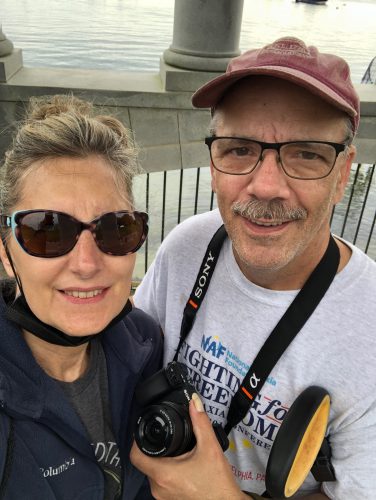John Mauro
Even in the year 2023, getting a diagnosis of a rare disease can feel scary and overwhelming. Now imagine getting the same diagnosis in 2005. Facebook was in its infancy and many of the other social media sites didn’t even exist. Practically no one used “Google” as a verb, as in “You should Google your rare disease to find out more!”
This is what happened to John Mauro. As he was drove home from his doctor’s appointment, he grappled with processing the diagnosis of ataxia his doctor gave him, figuring out how he would explain having this rare disease to his family and friends.
At home, he and his wife began searching the internet to find out more information. John described that this may not have been the best course of action, because what they found made him feel a bit fearful and overwhelmed. That fear subsided a bit when they discovered the National Ataxia Foundation (NAF) and learned that the organization would be holding a convention. John saw this as a learning opportunity and quickly registered to attend the event.
As John says, it wasn’t necessarily the keynote speakers who made a difference for him, but rather, meeting other patients impacted by ataxia. Connecting with patients and feeling like they understood what he was talking about because they shared the same rare disease was what made the most impact for him. John stated “I felt like I met my tribe…they get what I am talking about and I was learning from them.”

One of the first people John met was fellow ataxia patient Kyle Bryant, who is known for his podcast, Two Disabled Dudes, and also for riding a specially built tricycle (or trike) across America, including to the top of the highest paved road in North America. As John says, Kyle inspired him to get a trike of his own and begin doing rides to raise awareness for ataxia.
One way John made a unique contribution to raising awareness about ataxia was to use his skill set as a master chef to build a grand scale gingerbread man or gingerbread house. During the holidays, people would see John’s work on display in either local malls or in the Massachusetts State House. This gave people the opportunity to see the great accomplishments that someone in a wheelchair could complete, building this sweet confection on such a huge scale. He believes this was a very helpful way for him to provide education and awareness about ataxia to not only the public at large, but also to legislators in his home state.
John was part of the team who got the first state awareness day for ataxia, which is issued annually by the Massachusetts governor for September 25th. The New England Patriots of the National Football League (NFL) named John as one of the 2015 winners of the Myra Kraft Community MVP Awards. These awards, named in honor of the Patriots’ owner Robert Kraft’s widow Myra, recognize the contributions of New England residents who make a difference for their community. After the award, the Patriots also connected John with retired NFL players who had been in concussion protocols. John learned he had already had connection with some of them anonymously, as their symptoms often shared similarities with ataxia.
John joined the Board of Directors at the National Ataxia Foundation with two specific goals in mind:
- First, to give ataxia patients a strong voice, especially for those patients whose disease was taking away their ability to speak. During his time on the NAF Board, John helped grow the advocacy team and built relationships with multiple members of the US Congress, which allowed NAF to receive funding from the Department of Defense to support ataxia research.
- Second, John set out to improve the existing support groups. As an ataxia patient, John knows that often, the ability to speak clearly and quickly is taken from patients. When he’s working with support groups, he recognizes this and thinks of alternative ways to communicate, such as slowing his pace or allowing time for patients to respond, even if by text or chat functions. He also changed the name from support group, calling it “Team Ataxia”. John describes the group as non-traditional, instead of just sitting around talking, they take the meetings to a favorite restaurant or pub. He thinks this helps patients relax and just have meaningful conversations with one another. It gives patients a place to feel safe, heard, and most importantly, to have fun.
Although John’s wife can at times grow weary watching how ataxia has brought about changes for John and for their lives together, he describes her as one of his biggest supporters. There were times when she just wanted a break from all things revolving around ataxia, but she also encouraged him to make a list of all his accomplishments since his diagnosis. Importantly, she helped him develop a podcast to further ataxia education:
- The initial strategy was to highlight 25 facts about ataxia during the podcast. From there, John says it really took off. They now have a video studio and his wife conducts many of the interviews.
- Recently, the podcast reached an important milestone – over 650,000 downloads by audiences from over 80 countries throughout the world. John marvels that some listeners in Africa join in at 3AM (due to the time difference) just to be part of the community they’re creating.
- Although they put out a good amount of information, they try to deliver their message in short, digestible bursts, mainly due to shorter attention spans in today’s society.
When John is speaking for NAF, one of his favorite topics is utilizing all the tools in his toolbox. One such tool is a re-framing, for when they transition into using a wheelchair. He explains that ataxia causes him to walk differently, almost giving the appearance of being drunk. Fatigue compounds this symptom. To combat the fatigue, he uses a wheelchair, especially when he travels. Rather than looking at this as a negative, John re-frames the experience, as he knows the wheelchair is simply a device to save energy and make his life more enjoyable. He’s even found a way to make his wheelchair into a conversation starter, by decorating the air valves with colored lights. When adults and kids notice the lights, many think they’re really cool and it’s a fun thing that opens the door for discussion and education about ataxia.
One of John’s biggest success stories doesn’t revolve on a personal accomplishment, but rather around an opportunity that he had to help a local New England family whose two-year-old child was diagnosed with ataxia. John and his wife stepped in and showed the family how to navigate the school system and develop the tools for advocating for their child. They were able to find the school that would best help meet the child’s needs.
John said he has many followers on social media, and people thank him for the work he’s done, but this fame does have one drawback. Like some of the NFL legends John works with, he is often recognized. He jokingly complains it can be difficult to get out of a conference meeting room just to get food, as so many people are waiting to talk with him about how he’s helped with their ataxia journey.
If you find yourself traveling and happen to run into a man with really cool lights on his wheelchair, stop and have a conversation with him — you will definitely learn a few things about ataxia and living with a rare disease. For his efforts, we salute John Mauro as a Rare Disease Difference Maker ®.
